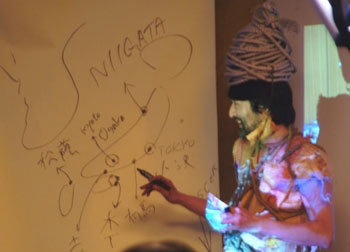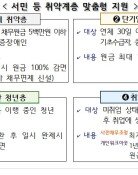Art Beyond Borders and Conflicts

On the afternoon of March 25, at the alternative exhibition space Loop in front of Hongik University, Seoul. Japanese artist Matsukage Hiroyuki stuck a page from a Korean magazine onto a wall, and as he tossed an arrow like a dart, the character won was punctured out of the infinite characters on the page. Based on the inspiration brought on by this letter, the artist began to draw on the wall with a pen.
Simultaneously, at a beer house called Latino, located approximately 50 meters from Loop, this behavior was being broadcasted on a widescreen TV. The group display created by 40-something Korean-Japanese colleagues, the 40 Display, thus raised its curtain.
A common notion of group exhibition is that it is a display with disordered artists pieces, but 40 Display banished conventions and progressed with 14 Korean and Japanese artists drawing on the exhibition space, or installing art works in a relay-fashion, around-the-clock. Regardless of genre, the exhibition consists of artists creating works out of inspiration from the previous artist until April 7.
Above all, the great attraction of the days events was the fact that 40-year-old Korean and Japanese artist colleagues sharing communication and friendship through the code of art were commemorating this years 40th anniversary of Korea-Japanese diplomacy at a time when Korean-Japanese relations are so high-strung. Four simultaneous translators aided them through language barriers.
In light of the recent deteriorating Korean-Japanese relations, substantial tension surrounded the exhibition and the tavern, with the sponsors mobilizing security in front of the buildings due to concerns of any mishaps. Within the buildings, however, merry laughter pervaded throughout the event. Korean artists Kim So-ra, Kim Hong-seok, Choi Jung-hwa, Jung Seo-young, Hong Sung-min, Lee Jong-myung, and Lee Mi-kyung, who participated in the exhibition, are notable artists even in Japan, holding joint Venice Biennale and Tokyo Mori Art Museum private exhibitions with Japanese artists Tsuyoshi Ozawa, Arima Sumitoshi, and seven other members of the artistic group Showa 40th Anniversary.
The name Showa 40th Anniversary originated from the historical name of Japan in 1965, the year they were born. As 386, Koreans born in 1965, created new frontiers in political, economical, and social generations, Japanese born in 1965 are also said to be the first generation to focus on personal and diverse everyday life, breaking away from a uniform and communal life.
The Korean and Japanese artists made impromptu works on the scene without prior preparation. The Japanese presented video works editing animation pieces or performances and dances, writing and singing techno songs, showing that they were truly the first generation to receive ritualistic images. On the other hand, Korean artists displayed relatively subdued pieces, such as a blind date performance, poetry recitation, and pictures of chocolates.
Japanese performer Ozawa said, The 40-somethings of Japan are the first to enjoy the fruits of Japans sophisticated development and globalization represented by the Tokyo Olympics that was launched a year before. The Japanese artists steadfastly replied, We dont care, to questions regarding the recent Dokdo islets issues. The group leader Matsukage Hiroyuki only responded, The majority of Japanese youth are of the post-war generations who did not experience the colonization or war, so they are just neighboring countries who wish to be friends with Korea.
The event on this day progressed all night with eager conversations and games of the Korean and Japanese artists, proving that the power of art goes well beyond borders and history. 02-3141-1377
Mun-Myung Huh angelhuh@donga.com






